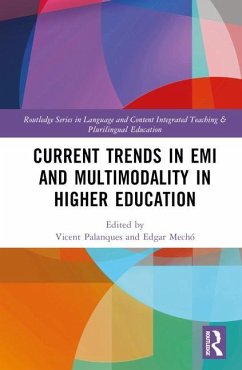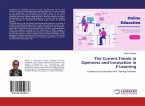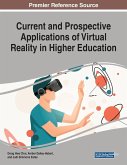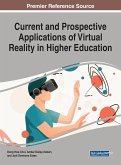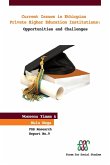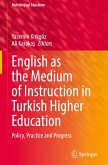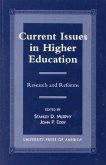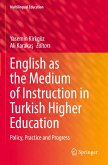Current Trends in EMI and Multimodality in Higher Education
Herausgeber: Beltrán-Palanques, Vicent; Bernad-Mechó, Edgar
Current Trends in EMI and Multimodality in Higher Education
Herausgeber: Beltrán-Palanques, Vicent; Bernad-Mechó, Edgar
- Gebundenes Buch
- Merkliste
- Auf die Merkliste
- Bewerten Bewerten
- Teilen
- Produkt teilen
- Produkterinnerung
- Produkterinnerung
Looking at both English Medium Instruction (EMI) and multimodality in higher education, this edited volume bridges the gap between the two contexts by offering various new insights into fundamentals in multilingual education, EMI discourse and current teaching practices in internationalised contexts.
Andere Kunden interessierten sich auch für
![The Current Trends in Openness and Innovation in E-Learning The Current Trends in Openness and Innovation in E-Learning]() Sixbert SangwaThe Current Trends in Openness and Innovation in E-Learning28,99 €
Sixbert SangwaThe Current Trends in Openness and Innovation in E-Learning28,99 €![Current and Prospective Applications of Virtual Reality in Higher Education Current and Prospective Applications of Virtual Reality in Higher Education]() Current and Prospective Applications of Virtual Reality in Higher Education164,99 €
Current and Prospective Applications of Virtual Reality in Higher Education164,99 €![Current and Prospective Applications of Virtual Reality in Higher Education Current and Prospective Applications of Virtual Reality in Higher Education]() Current and Prospective Applications of Virtual Reality in Higher Education215,99 €
Current and Prospective Applications of Virtual Reality in Higher Education215,99 €![Current Issues in Ethiopian Private Higher Education Institutions. Opportunities and Challenges Current Issues in Ethiopian Private Higher Education Institutions. Opportunities and Challenges]() Wossenu YimamCurrent Issues in Ethiopian Private Higher Education Institutions. Opportunities and Challenges37,99 €
Wossenu YimamCurrent Issues in Ethiopian Private Higher Education Institutions. Opportunities and Challenges37,99 €![English as the Medium of Instruction in Turkish Higher Education English as the Medium of Instruction in Turkish Higher Education]() English as the Medium of Instruction in Turkish Higher Education112,99 €
English as the Medium of Instruction in Turkish Higher Education112,99 €![Current Issues in Higher Education Current Issues in Higher Education]() Stanley D MurphyCurrent Issues in Higher Education111,99 €
Stanley D MurphyCurrent Issues in Higher Education111,99 €![English as the Medium of Instruction in Turkish Higher Education English as the Medium of Instruction in Turkish Higher Education]() English as the Medium of Instruction in Turkish Higher Education112,99 €
English as the Medium of Instruction in Turkish Higher Education112,99 €-
-
-
Looking at both English Medium Instruction (EMI) and multimodality in higher education, this edited volume bridges the gap between the two contexts by offering various new insights into fundamentals in multilingual education, EMI discourse and current teaching practices in internationalised contexts.
Hinweis: Dieser Artikel kann nur an eine deutsche Lieferadresse ausgeliefert werden.
Hinweis: Dieser Artikel kann nur an eine deutsche Lieferadresse ausgeliefert werden.
Produktdetails
- Produktdetails
- Verlag: Routledge
- Seitenzahl: 266
- Erscheinungstermin: 8. Juli 2024
- Englisch
- Abmessung: 240mm x 161mm x 19mm
- Gewicht: 567g
- ISBN-13: 9781032071312
- ISBN-10: 1032071311
- Artikelnr.: 69433445
- Herstellerkennzeichnung
- Libri GmbH
- Europaallee 1
- 36244 Bad Hersfeld
- gpsr@libri.de
- Verlag: Routledge
- Seitenzahl: 266
- Erscheinungstermin: 8. Juli 2024
- Englisch
- Abmessung: 240mm x 161mm x 19mm
- Gewicht: 567g
- ISBN-13: 9781032071312
- ISBN-10: 1032071311
- Artikelnr.: 69433445
- Herstellerkennzeichnung
- Libri GmbH
- Europaallee 1
- 36244 Bad Hersfeld
- gpsr@libri.de
Vicent Beltrán-Palanques is Associate Professor in the Department of English Studies at the Universitat Jaume I, Spain. His research interests focus on ESP/EAP pedagogy, English-Medium Instruction in higher education, multimodal discourse analysis and multimodal literacy and pragmatics and interaction. He has published in international journals such as System, Journal of English for Academic Purposes and English for Specific Purposes , as well as in international publishing houses like Routledge, Brill and Springer. Edgar Bernad-Mechó is Associate Professor at Universitat Jaume I, Spain. He specialises in the use of metadiscourse and multimodality in academic contexts and for science dissemination. He has published papers in journals like the Journal of English for Academic Purposes or Discourse Studies, and co-edited a special issue on multimodality for Ibérica. In his recent studies he has explored the modal density and coherence of YouTube videos for science dissemination and looked at the use of humor and other engagement strategies in science communication online.
Introduction: A multimodal perspective on content and language teaching in
higher education.Vicent Beltrán-Palanques & Edgar Bernad-Mechó Chapter 1:
The multimodal turn in higher education. Fei Victor Lim Section 1: Content
and language-oriented classrooms 2. Chapter 2: English-medium instruction
(EMI) multimodal classroom discourse to enhance L2 university students'
comprehension. Natalia Norte & Teresa Morell 3. Chapter 3: Multimodal
orchestration for socal science-specific meaning - making flow in higher
education. Phoebe Siu, Esther Ka-Man Tong & Winfred Wenhui Xuan 4. Chapter
4: Listening to silence in Spanish and English-medium instruction online
lectures. Mercedes Querol-Julián & Maite Amondarain Garrido 5. Chapter 5:
The role of multimodal competence in 'doing EMI lecturing': Exploring the
effectiveness of non-linguistic resources in EMI. Balbina Moncada-Comas &
Maria Sabaté-Dalmau 6. Chapter 6: A proposal for CLIL teacher training:
Acknowledging multimodal literacies as pedagogical affordances in
CLILicised Physical Education Celina Salvador-Garcia & Noelia Ruiz-Madrid
Section 2: ESP/EAP and multimodality 7. Chapter 7: Strategic
translanguaging and trans-semiotizing in an English for academic purposes
class: A multimodal analysis. Jiajia Eve Liu, Yuen Yi Lo & Angel M. Y. Lin
8. Chapter 8: Preparing doctoral students for conference presentations:
Teaching multimodal academic literacy and the role of organizational
metadiscourse Vicent Beltrán-Palanques & Edgar Bernad-Mechó 9. Chapter 9:
Training students in multimodal pragmatics for the Integration of Content
and Language in business university studies Nuria Edo-Marzá & Inmaculada
Fortanez-Gómez 10. Chapter 10: Digital multimodal composing in the teaching
of English for business communication: A genre-based analysis of
student-authored videos Yi Deng & Dezheng (William) Feng 11. Concluding
chapter - The wood and the trees: Evaluating multimodality in
English-medium higher education through the ROAD-MAPPING lens Ute Smit
higher education.Vicent Beltrán-Palanques & Edgar Bernad-Mechó Chapter 1:
The multimodal turn in higher education. Fei Victor Lim Section 1: Content
and language-oriented classrooms 2. Chapter 2: English-medium instruction
(EMI) multimodal classroom discourse to enhance L2 university students'
comprehension. Natalia Norte & Teresa Morell 3. Chapter 3: Multimodal
orchestration for socal science-specific meaning - making flow in higher
education. Phoebe Siu, Esther Ka-Man Tong & Winfred Wenhui Xuan 4. Chapter
4: Listening to silence in Spanish and English-medium instruction online
lectures. Mercedes Querol-Julián & Maite Amondarain Garrido 5. Chapter 5:
The role of multimodal competence in 'doing EMI lecturing': Exploring the
effectiveness of non-linguistic resources in EMI. Balbina Moncada-Comas &
Maria Sabaté-Dalmau 6. Chapter 6: A proposal for CLIL teacher training:
Acknowledging multimodal literacies as pedagogical affordances in
CLILicised Physical Education Celina Salvador-Garcia & Noelia Ruiz-Madrid
Section 2: ESP/EAP and multimodality 7. Chapter 7: Strategic
translanguaging and trans-semiotizing in an English for academic purposes
class: A multimodal analysis. Jiajia Eve Liu, Yuen Yi Lo & Angel M. Y. Lin
8. Chapter 8: Preparing doctoral students for conference presentations:
Teaching multimodal academic literacy and the role of organizational
metadiscourse Vicent Beltrán-Palanques & Edgar Bernad-Mechó 9. Chapter 9:
Training students in multimodal pragmatics for the Integration of Content
and Language in business university studies Nuria Edo-Marzá & Inmaculada
Fortanez-Gómez 10. Chapter 10: Digital multimodal composing in the teaching
of English for business communication: A genre-based analysis of
student-authored videos Yi Deng & Dezheng (William) Feng 11. Concluding
chapter - The wood and the trees: Evaluating multimodality in
English-medium higher education through the ROAD-MAPPING lens Ute Smit
Introduction: A multimodal perspective on content and language teaching in
higher education.Vicent Beltrán-Palanques & Edgar Bernad-Mechó Chapter 1:
The multimodal turn in higher education. Fei Victor Lim Section 1: Content
and language-oriented classrooms 2. Chapter 2: English-medium instruction
(EMI) multimodal classroom discourse to enhance L2 university students'
comprehension. Natalia Norte & Teresa Morell 3. Chapter 3: Multimodal
orchestration for socal science-specific meaning - making flow in higher
education. Phoebe Siu, Esther Ka-Man Tong & Winfred Wenhui Xuan 4. Chapter
4: Listening to silence in Spanish and English-medium instruction online
lectures. Mercedes Querol-Julián & Maite Amondarain Garrido 5. Chapter 5:
The role of multimodal competence in 'doing EMI lecturing': Exploring the
effectiveness of non-linguistic resources in EMI. Balbina Moncada-Comas &
Maria Sabaté-Dalmau 6. Chapter 6: A proposal for CLIL teacher training:
Acknowledging multimodal literacies as pedagogical affordances in
CLILicised Physical Education Celina Salvador-Garcia & Noelia Ruiz-Madrid
Section 2: ESP/EAP and multimodality 7. Chapter 7: Strategic
translanguaging and trans-semiotizing in an English for academic purposes
class: A multimodal analysis. Jiajia Eve Liu, Yuen Yi Lo & Angel M. Y. Lin
8. Chapter 8: Preparing doctoral students for conference presentations:
Teaching multimodal academic literacy and the role of organizational
metadiscourse Vicent Beltrán-Palanques & Edgar Bernad-Mechó 9. Chapter 9:
Training students in multimodal pragmatics for the Integration of Content
and Language in business university studies Nuria Edo-Marzá & Inmaculada
Fortanez-Gómez 10. Chapter 10: Digital multimodal composing in the teaching
of English for business communication: A genre-based analysis of
student-authored videos Yi Deng & Dezheng (William) Feng 11. Concluding
chapter - The wood and the trees: Evaluating multimodality in
English-medium higher education through the ROAD-MAPPING lens Ute Smit
higher education.Vicent Beltrán-Palanques & Edgar Bernad-Mechó Chapter 1:
The multimodal turn in higher education. Fei Victor Lim Section 1: Content
and language-oriented classrooms 2. Chapter 2: English-medium instruction
(EMI) multimodal classroom discourse to enhance L2 university students'
comprehension. Natalia Norte & Teresa Morell 3. Chapter 3: Multimodal
orchestration for socal science-specific meaning - making flow in higher
education. Phoebe Siu, Esther Ka-Man Tong & Winfred Wenhui Xuan 4. Chapter
4: Listening to silence in Spanish and English-medium instruction online
lectures. Mercedes Querol-Julián & Maite Amondarain Garrido 5. Chapter 5:
The role of multimodal competence in 'doing EMI lecturing': Exploring the
effectiveness of non-linguistic resources in EMI. Balbina Moncada-Comas &
Maria Sabaté-Dalmau 6. Chapter 6: A proposal for CLIL teacher training:
Acknowledging multimodal literacies as pedagogical affordances in
CLILicised Physical Education Celina Salvador-Garcia & Noelia Ruiz-Madrid
Section 2: ESP/EAP and multimodality 7. Chapter 7: Strategic
translanguaging and trans-semiotizing in an English for academic purposes
class: A multimodal analysis. Jiajia Eve Liu, Yuen Yi Lo & Angel M. Y. Lin
8. Chapter 8: Preparing doctoral students for conference presentations:
Teaching multimodal academic literacy and the role of organizational
metadiscourse Vicent Beltrán-Palanques & Edgar Bernad-Mechó 9. Chapter 9:
Training students in multimodal pragmatics for the Integration of Content
and Language in business university studies Nuria Edo-Marzá & Inmaculada
Fortanez-Gómez 10. Chapter 10: Digital multimodal composing in the teaching
of English for business communication: A genre-based analysis of
student-authored videos Yi Deng & Dezheng (William) Feng 11. Concluding
chapter - The wood and the trees: Evaluating multimodality in
English-medium higher education through the ROAD-MAPPING lens Ute Smit

